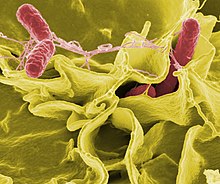
Back سلمونيلا Arabic سالمونيلا ARZ Salmonella AST Salmonella BS Salmonel·la Catalan سەلمۆنێلا CKB Salmonella Czech Salmonela Welsh Salmonella Danish Salmonellen German
| Salmonella | |
|---|---|

| |
| Color-enhanced scanning electron micrograph showing Salmonella Typhimurium (red) invading cultured human cells | |
| Scientific classification | |
| Domain: | Bacteria |
| Phylum: | Pseudomonadota |
| Class: | Gammaproteobacteria |
| Order: | Enterobacterales |
| Family: | Enterobacteriaceae |
| Genus: | Salmonella Lignières, 1900 |
| Species and subspecies[1] | |
| |
Salmonella is a genus of rod-shaped (bacillus) gram-negative bacteria of the family Enterobacteriaceae. The two known species of Salmonella are Salmonella enterica and Salmonella bongori. S. enterica is the type species and is further divided into six subspecies[2][3] that include over 2,650 serotypes.[4] Salmonella was named after Daniel Elmer Salmon (1850–1914), an American veterinary surgeon.
Salmonella species are non-spore-forming, predominantly motile enterobacteria with cell diameters between about 0.7 and 1.5 μm, lengths from 2 to 5 μm, and peritrichous flagella (all around the cell body, allowing them to move).[5] They are chemotrophs, obtaining their energy from oxidation and reduction reactions, using organic sources. They are also facultative anaerobes, capable of generating adenosine triphosphate with oxygen ("aerobically") when it is available, or using other electron acceptors or fermentation ("anaerobically") when oxygen is not available.[5]
Salmonella species are intracellular pathogens,[6] of which certain serotypes cause illness such as salmonellosis. Most infections are due to the ingestion of food contaminated by feces. Typhoidal Salmonella serotypes can only be transferred between humans and can cause foodborne illness as well as typhoid and paratyphoid fever. Typhoid fever is caused by typhoidal Salmonella invading the bloodstream, as well as spreading throughout the body, invading organs, and secreting endotoxins (the septic form). This can lead to life-threatening hypovolemic shock and septic shock, and requires intensive care including antibiotics.
Nontyphoidal Salmonella serotypes are zoonotic and can be transferred from animals and between humans. They usually invade only the gastrointestinal tract and cause salmonellosis, the symptoms of which can be resolved without antibiotics. However, in sub-Saharan Africa, nontyphoidal Salmonella can be invasive and cause paratyphoid fever, which requires immediate antibiotic treatment.[7]
- ^ "Salmonella". NCBI taxonomy. Bethesda, MD: National Center for Biotechnology Information. Retrieved 27 January 2019.
- ^ Su LH, Chiu CH (2007). "Salmonella: clinical importance and evolution of nomenclature". Chang Gung Medical Journal. 30 (3): 210–219. PMID 17760271.
- ^ Ryan MP, O'Dwyer J, Adley CC (2017). "Evaluation of the Complex Nomenclature of the Clinically and Veterinary Significant Pathogen Salmonella". BioMed Research International. 2017: 3782182. doi:10.1155/2017/3782182. PMC 5429938. PMID 28540296.
- ^ Gal-Mor O, Boyle EC, Grassl GA (2014). "Same species, different diseases: how and why typhoidal and non-typhoidal Salmonella enterica serovars differ". Frontiers in Microbiology. 5: 391. doi:10.3389/fmicb.2014.00391. PMC 4120697. PMID 25136336.
- ^ a b Fàbrega A, Vila J (April 2013). "Salmonella enterica serovar Typhimurium skills to succeed in the host: virulence and regulation". Clinical Microbiology Reviews. 26 (2): 308–341. doi:10.1128/CMR.00066-12. PMC 3623383. PMID 23554419.
- ^ Jantsch J, Chikkaballi D, Hensel M (March 2011). "Cellular aspects of immunity to intracellular Salmonella enterica". Immunological Reviews. 240 (1): 185–195. doi:10.1111/j.1600-065X.2010.00981.x. PMID 21349094. S2CID 19344119.
- ^ Ryan I KJ, Ray CG, eds. (2004). Sherris Medical Microbiology (4th ed.). McGraw Hill. pp. 362–8. ISBN 978-0-8385-8529-0.
© MMXXIII Rich X Search. We shall prevail. All rights reserved. Rich X Search